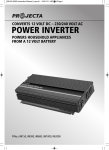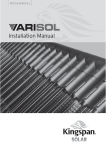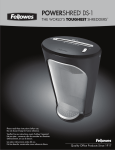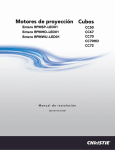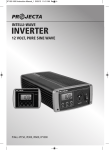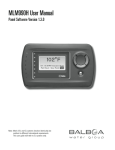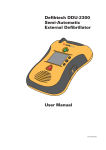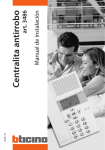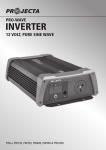Download Projecta IM2000 Operating instructions
Transcript
IM2000-24 Instruction Manual_Layout 1 19/01/12 4:38 PM Page 1
CONVERTS 24 VOLT DC – 230/240 VOLT AC
POWER INVERTER
POWERS HOUSEHOLD APPLIANCES
FROM A 24 VOLT BATTERY
P/No.s IM1000-24, IM2000-24
IM2000-24 Instruction Manual_Layout 1 19/01/12 4:38 PM Page 2
WARNING
UÊÊ ÀÊÕÃiÊÜÌ
Êi}>ÌÛiÞÊi>ÀÌ
i`ÊÛi
ViÃÊEÊÃÞÃÌiÃÊÞ°Ê
UÊÊ ÀÊ`ÀÊÕÃiÊÕÌÊvÊÜi>Ì
iÀÊÞ°
UÊÊ ÌiÀ>ÞÊL`i`ÊvÀÊÃ>viÌÞ]ÊL>ÌÌiÀÞÊ
Êi}>ÌÛiÊÌÊV>ÃiÊEÊ
ÊÃViÌÊi>ÀÌ
Ê°
UÊÊ >â>À`ÕÃÊÛÌ>}iÊÃ`iÊÊ`ÊÌÊ>ÌÌi«ÌÊÌÊ«iÊÀÊÀi«>À°Ê
UÊÊ ÊÌÊÕÃiÊvÊ`>>}i`°
UÊÊ ,i>`Ê«iÀ>Ì}Ê>Õ>ÊLivÀiÊÕÃ}ÊÀÊ>}Ê>ÞÊViVÌð
UÊÊ "ÞÊViVÌÊÓÎäÉÓ{ä6Ê
Ê>««>ViÃÊÌ
>ÌÊ>ÀiÊÊÃ>viÊV`Ì°Ê
UÊÊ ÌÊÃÊÀiVi`i`ÊÌ
>ÌÊ>ÊÌÞ«iʼ½Ê«ÀÌ>LiÊÀiÃ`Õ>ÊVÕÀÀiÌÊ`iÛViÊ,
®Ê
Ê LiÊÕÃi`ÊvÀÊ>``i`ÊÕÌ«ÕÌÊ«ÀÌiVÌ°
UÊ ÀÊ`i«i`iÌÊÕÃi]Ê`ÊÌÊViVÌÊÌÊLÕ`}ð
FEATURES
UÊÊ*i>Ê*ÜiÀÊ/iV
}ÞÊÀÕÃÊ>««>ViÃÊÜÌ
Ê
}
ÊÃÌ>ÀÌÊÕ«Ê>`ð
UÊ
UÊ ÕÌÊÊÃ>viÌÞÊ«ÀÌiVÌÊ>}>ÃÌÊ
Ê«ÜiÀÊÛiÀ>`Ê>`ÊÜÊL>ÌÌiÀÞ°
UÊ i>ÛÞÊÕÌÞÊ«ÜiÀÊi>`ÃÊvÀÊ`ÀiVÌÊL>ÌÌiÀÞÊViVÌ°
UÊ ««ÀÛi`Ê-É <-Ê«ÜiÀÊÕÌiÌÊÃViÌðÊ
UÊ /ÜÊ«ÜiÀÊÕÌiÌÊÃViÌð
UÊ /i«iÀ>ÌÕÀiÊVÌÀi`Ê>ÕÌ>ÌVÊV}Êv>°Ê
-*
/" -\Ê
P/No.
Input
Input Current: (Max DC Amps)
Input Standby Current (+/-5%)
Output
Continuous Output Power (Watt)
Peak Output Power (Watts)
Efficiency
Low Battery Alarm/Shutdown
Cooling Fan
Thermal Shutdown
Replacement Fuse
Fuse Quantity & Size
Fuse Location
Connection Cable
Dimensions (cm)
Weight
2
IM1000-24
IM2000-24
24V Battery/Vehicle (20-30 Volt DC)
60A
120A
400mA
600mA
230/240 Volt AC, 50Hz (Modified Sine Wave)
1000W
2000W
2000W
4000W
85 - 90%
Alarm 21.0 Volt/Shutdown 20.0 Volt ((0.2 Volt)
Automatic temperature controlled
65º ((5ºC)
Standard Auto Blade Fuse
6 x 10A
12 x 10A
Internal*
Internal*
16mm2/1100mm
25mm2/1100mm
24 x 30 x 7.7
20.5 x 29 x 15.5
3.1kg
4.8kg
IM2000-24 Instruction Manual_Layout 1 19/01/12 4:38 PM Page 3
WHAT IS AN INVERTER?
Inverters are designed for powering household appliances from a battery or vehicle. They are
electronic devices that convert battery power to (230/240V AC) mains power.
Inverters are compact and often lightweight making them an ideal source of portable mains power.
Thanks to their portability they are commonly used in cars, caravans, motor homes, boats, 4WD’s,
utility vehicles, trucks and buses.
Using an inverter with standard household appliances is a much cheaper option than purchasing
specialised 12V or 24V appliances for times when power is not available.
between the two is how close the output replicates mains power.
ed sine wave and true
sine wave inverters.
400
400
400
300
300
300
200
200
200
100
100
100
0
0
0
-100
-100
-100
-200
-200
-200
-300
-300
-300
-400
-400
MAINS POWER (SINE WAVE)
-400
MODIFIED SINE WAVE
TRUE SINE WAVE
Logically it follows that the process used in a true sine wave inverter is more complex than a modied sine wave inverter and subsequently they are lot more expensive.
ed sine wave and hence they are
more common.
True sine wave inverters are reserved for use on medical equipment and sensitive electrical
appliances.
Inverters are available with different power output levels to suit the type of appliances to be
powered. Small inverters are designed for powering one small low power electrical or electronic
appliance. Larger inverters can be used to power multiple small appliances or one larger appliance.
cient method for running appliances with very high power requirements such as electric heaters, stoves, kettles and air conditioners. This is due to their high current
draw and battery consumption.
3
IM2000-24 Instruction Manual_Layout 1 19/01/12 4:38 PM Page 4
CONNECTIONS / CONTROLS & ACCESSORIES
After unpacking your inverter take a moment to check that you have all the correct accessories for
your model and familiarise yourself with the connections and controls.
P/No. IM1000-24
AC OUTPUT
SOCKETS
POWER & FAULT
LIGHTS
POWER ON
SWITCH
DC TERMINALS
FAN
CHASSIS GND
FRONT
Supplied:
U Operating instructions
U
U
REAR
tted with ring terminal (1100mm)
tted with ring terminal (1100mm)
P/No. IM2000-24
Twin outlet
sockets
Power ON
L.E.D
Normal
operation
L.E.D
Fault warning L.E.D
and audible beep
Compact alumimium housing
with high efficiency cooling fins
Heavy-duty DC
connection terminals
ON/OFF
Switch
AC OUTPUT
AS/NZS
approved sockets
Internal protection fuse
FRONT
Supplied:
U Operating instructions
U
U
4
Temperature controlled
automatic cooling fan
Mounting brackets
REAR
tted with ring terminal (1100mm)
tted with ring terminal (1100mm)
IM2000-24 Instruction Manual_Layout 1 19/01/12 4:38 PM Page 5
PLACEMENT / LOCATION / MOUNTING OF INVERTER
Caution:
UÊ
UÊ Batteries should be mounted in a separate well-vented enclosure.
UÊ For vehicle or camping use the inverter must be protected from rain, water or moisture.
Projecta inverters are designed for indoor, out of weather use only. For best performance the
inverter must be used or mounted in a cool, dry, clean and well-ventilated area.
For best TV / Radio reception keep inverter as far away from TV’s, radios, antenna cables and
antennas as possible.
All models are supplied with mounting brackets if used in mobile applications such as 4WD,
Caravan, Motor home or boat the inverter should be mounted to a suitable horizontal or vertical
panel, with a least 20cm clearance from the rear panel of the inverter to provide good ventilation for
the cooling fan.
SUITABLE POWER SOURCE:
In order to operate the inverter and supply power to an appliance a suitable 24V DC power supply
is required. This can be vehicle or caravan batteries, portable power pack or 2 independent 12V
batteries joined in series to produce 24VDC. For most applications, deep cycle batteries are
recommended for best performance.
The size of the batteries used will determine how long the inverter will supply power to an
appliance and how well the inverter will perform. Most batteries are marked with their size in Amp
hours (Ah) or Cold Cranking Amps (CCA).
Because inverters are capable of drawing high currents the inverter should only be connected to
suitable size batteries. Connection to undersized batteries could damage the batteries and will
result in the inverter shutting down within a short period due to low battery voltage.
The amount of power drawn from the batteries is proportional to the inverter load.
P/No.
IM1000-24
IM2000-24
Minimum Recommended
Battery Size
40Ah (350CCA)
50Ah (400CCA)
Run time with maximum load &
minium battery size
15min
5min
Run time for a 100 Watt globe
with minimum battery size
6 hours
7 hours
Ideal battery size
40-130Ah
50-200Ah
5
IM2000-24 Instruction Manual_Layout 1 19/01/12 4:38 PM Page 6
CONNECTION TO POWER SOURCE & EARTHING
U
U
U
U
Caution:
Even though the inverter is powered from batteries, it still produces Dangerous High Voltage
AC power and has the potential to fatally injure if incorrectly installed or used.
Before making any connections ensure inverter is switched off and has no AC appliances
plugged into the AC output sockets.
Ensure vehicle / system is a negative earthed or negative ground system only.
Double check battery negative and positive posts before making any connection, a wrong
connection (Reverse polarity) will cause the fuse/s to blow and may damage the inverter.
U
when the inverter has not been used for some time. This spark is caused by the inverter’s large
capacitors charging quickly. To minimise this, make the last connection quickly and completely.
U
U Batteries can be dangerous, follow all battery manufacturer’s instructions and warnings.
U Projecta inverters are designed FOR INDEPENDENT USE ONLY. That is, they cannot be
connected to household wiring whether the building is connected to the electricity grid or not.
U Never operate the inverter without the DC negative input connected direct to the battery and
never install a fuse, circuit breaker or battery switch in the negative supply line.
These inverters can be connected to a power source on a temporary basis with the supplied
DC leads (see the section Temporary Connection) or hard wired for a permanent installation
with suitably sized cable and hardware for your application (see the section Hard Wired
Connection). Regardless of which connection method is used it may be advantageous to earth
the inverter case, see the section on External Earthing for more details.
TEMPORARY CONNECTION:
U Connect the ring terminal on the negative lead (Black) to the negative (Black) DC terminal on
the back of the inverter.
U Connect the ring terminal on the other end of the lead to the negative DC supply or
(-) battery terminal.
U Connect the ring terminal on the positive lead (Red) to the positive (Red) DC terminal on the
back of the inverter.
U Connect the ring terminal on the other end of the lead to the positive DC supply or
(+) battery terminal.
INPUT
POS.
CHASSIS
GND
6
+
INPUT
NEG.
–
IM2000-24 Instruction Manual_Layout 1 19/01/12 4:38 PM Page 7
“HARD WIRED” CONNECTION
When mounting the inverter in a vehicle, caravan, boat, truck or cabin it may be preferable to use
longer DC battery cables than those supplied, so that the inverter can be placed in a more convenient, cooler or more protected location.
If longer cables are required only use suitably insulated automotive battery cable according to the
following table (Note: B&S = AWG)
P/No.
IM1000-24
IM2000-24
Up to 2m
6 B&S (14mm2)
3 B&S (26mm2)
3m
3 B&S (26mm2)
2 B&S (32mm2)
4m
2 B&S (32mm2)
0 B&S (49mm2)
6m
0 B&S (49mm2)
00 B&S (64mm2)
UÊÌÊÃÊÀiVi`i`ÊÌ
>ÌÊ>ÊVÀVÕÌÊLÀi>iÀÊÀÊ
}
ÊVÕÀÀiÌÊvÕÃiÊLiÊ«>Vi`ÊÊÌ
iÊ
Ê«ÃÌÛiʳ®ÊiÊ
close to the batteries.
P/No.
IM1000-24
IM2000-24
Fuse or Circuit
Ài>iÀÃÊÃâiʳ®Ê"Þ
75AMP
150AMP
UÊÌÊÃÊÀiVi`i`ÊÌ
>ÌÊ>Ê
i>ÛÞÊ`ÕÌÞÊL>ÌÌiÀÞÊÃÜÌV
ÊÜÌ
Ê>ÊVÕÀÀiÌÊÀ>Ì}Ê
}
iÀÊÌ
>ÊÌ
iÊvÕÃiÊ
ÌÌi`ÊÊÌ
iÊ
Ê«ÃÌÛiʳ®ÊiÊVÃiÊÌÊÌ
iÊL>ÌÌiÀiÃÊÌÊ>ÜÊÌ
iÊÃÕ««ÞÊÌÊÌ
iÊÛiÀÌiÀÊÌÊLiÊ
switched off, this can also be achieved by using a circuit breaker which has a trip facility.
UÊ*ÃÌÛiÊ>`Ê i}>ÌÛiÊV>LiÃÊÃ
Õ`ÊLiÊÀÕÊVÃiÊÌ}iÌ
iÀÊÌÊÀi`ÕViÊV>LiÊ`ÕVÌ>Vi]Ê>`ÊLiÊ
protected from damage by corrugated conduit.
FUSE
SWITCH
CORRUGATED CONDUIT
7
IM2000-24 Instruction Manual_Layout 1 19/01/12 4:38 PM Page 8
EXTERNAL EARTHING: (OPTIONAL)
Projecta inverters have been internally bonded for safety, by connecting the AC socket/s earth pin to
the inverter case and to the DC negative supply input. Because of this most installations do not
require the inverter to be earthed. However if the inverter is used in a stationary land based
application or if the inverter is causing interference with TV sets or radios it is recommended that an
external earth connection is made by one of the following methods:.
U External Earthing Stationary Applications --Connect an earth wire (Preferably solid Green
or Green with Yellow stripe) from the external earth connection (Chassis GND) on the rear of the
inverter to a metal stake or pipe that is driven into the ground at least 1.2m.
EARTH STAKE 1.2M
U External Earthing Mobile Applications --Connect an earth wire (Preferably solid Green or Green
with Yellow stripe) from the external earth connection (Chassis GND) on the rear of the inverter to
the chassis of the vehicle or ground wires in a boat.
CHASSIS CONNECTION
8
IM2000-24 Instruction Manual_Layout 1 19/01/12 4:38 PM Page 9
OPERATION
Caution:
U Always switch off the appliance and inverter before recharging the batteries or starting
the vehicle engine.
U
connected to the mains grid. Normally AC wiring contains a M.E.N. link, this neutral to earth
link will damage the inverter.
U This inverter is designed for direct connection to appliances however extension leads and
power boards can be used.
PROTECTION FEATURES
Projecta inverters include sophisticated circuitry that monitors the operation of the inverter and turns
the inverter off if a problem is detected. The “Fault” light will illuminate and an audible alarm will be
heard if this occurs. This prevents damage to the inverter, batteries or appliance being powered.
U Low Battery - This feature will sound a continuous alarm when the batteries powering the
inverter are low (21 Volts). It is recommended that the appliance is turned off, then the inverter
is also turned off and the batteries are recharged.
If the appliance is allowed to continue to run, the inverter will turn off when the batteries are very
low (20.0 Volts) to prevent damage to the batteries or inverter. This will cause a sudden disruption of
power to the appliance that may cause problems for some appliances, for example most computers
that need to be shut down properly.
U Overload - This feature will sound an alarm and turn the inverter off when the total load
connected to the inverter exceeds the inverter’s rating (see “Determining suitable load/appliance”)
This may also occur due to highly inductive loads such as any appliance with a motor causing a
sudden peak load on the inverter.
If this occurs, switch “OFF” the appliance and the inverter
After 2 seconds turn the inverter “ON” and the inverter will provide power again. Turn the appliance
“ON”, if the inverter shuts down more than 3 times, it is likely that the appliance is drawing more
load than the inverter can supply, and a larger inverter would be recommended.
UÊ}
ÊÌi«iÀ>ÌÕÀiÊ/
ÃÊvi>ÌÕÀiÊÜÊÌÕÀÊÌ
iÊÛiÀÌiÀÊvvÊvÊÌ
iÊÛiÀÌiÀÊ
>ÃÊÀi>V
i`Ê>Ê
}
Ê
temperature. This may occur from continuously running a high load for long periods, due to high
ambient temperatures or due to poor ventilation around the inverter. If this occurs, turn the inverter
off and allow to cool for at least 15 minutes before resuming operation. Where possible reduce the
load on the inverter and improve ventilation.
9
IM2000-24 Instruction Manual_Layout 1 19/01/12 4:38 PM Page 10
DETERMINING SUITABLE LOAD / APPLIANCES:
tted with 2 approved AS/NZS Australian socket outlets. Both sockets can be used,
as long as the combined load (Watts required to run appliance) does not exceed the inverter’s
continuous rating and the load connected to one socket does not exceed 2400 Watts (10Amps). All
appliances have a rating plate that show the amount of power (Watts) used or the current (Amps)
drawn under normal use.
The following table shows the maximum combined AC Watts or AC Amps which can be run
by the inverter.
P/No.
IM1000-24
IM2000-24
AC Combined max load (Watts)
1000W
2000W
AC Combined max load (Amps)
4.0 Amps
8.0 Amps
Some appliances that use an electric motor or transformer may draw 2 to 6 times their rating when
cult for the inverter to run. For
these appliances it is often a matter of trial and error to see what size inverter they will run on, if in
doubt always use a larger inverter, use the following table as a guide. The DC Amps column shows
the approximate power drawn from the 24 Volt supply.
Approximate
AC Watts
DC Amps
Circular Power Saw/Electric Chainsaw
Toaster/Sandwich Maker
Small Household Vacuum Cleaner
Belt Sander & other Power Tools
Small Microwave Oven (500/600W)*
Combo TV/VCR
Power Drill/Portable Grinder
Flood Lights (500W)
Submersible Pump*
Small Colour Television*
Small Power Tools/Flourescent Light*
Juicer/Blender
Bar Fridge*/Large Stereo/PA Amplifier
Hand Mixer
Laptop Computer/Electric Knife
Portable Stereo/CD/DVD/VCR/Playstation
Charger/Mobile Phone/Camera/Camcorder
Shaver
2000
1500
1250
1000
900
750
600
500
400
350
300
250
200
175
150
100
50
25
*Appliance may require a larger inverter.
10
IM1000-24
IM2000-24
APPLICATION CHART
Appliance
87
70
47
46
41
34
25
23
18
16
14
11
9
8
6
4
2
1
IM2000-24 Instruction Manual_Layout 1 19/01/12 4:38 PM Page 11
CONNECTING APPLIANCE AND RUNNING INVERTER
UÊÊ
iVÌÊÌ
iÊ>««>ViÊ
Ê«Õ}ÊÌÊÌ
iÊÛiÀÌiÀÊ
ÊÕÌiÌÊÃViÌ°
UÊÊ-ÜÌV
ÊÌ
iÊÛiÀÌiÀʺ" »]ÊÌ
iʺÀii»Ê«ÜiÀÊ}
ÌÊÜÊÕ>ÌiÊÌÊ`V>ÌiÊ«iÀ>Ì°
UÊÊ
Ê ÛiÀÌiÀÊÊLivÀiÊÃÜÌV
}ÊÌ
iÊ>««>ViÊÊ>`Ê>Ü>ÞÃÊÌÕÀÊÌ
iÊ>««>ViÊvvÊLivÀiÊ
Ê ÃÜÌV
}ÊÌ
iÊÛiÀÌiÀÊvv°
UÊ 7
iÊÌÊÊÕÃiÊÌÕÀÊÌ
iÊÛiÀÌiÀÊvv°
Ê Ê
(1) SWITCH ON
(2) SWITCH ON
RESIDUAL CURRENT DEVICE (RCD)
ÀÊ>``i`ÊÃ>viÌÞÊÌÊÃÊÀiVi`i`ÊÌ
>ÌÊ>Ê/Þ«iʺ»Ê,iÃ`Õ>Ê
ÕÀÀiÌÊiÛViÊ,
®ÊLiÊÕÃi`ÊvÀÊ>ÞÊ
>««>ViÊÌ
>ÌÊÃÊLi}Ê«iÀ>Ìi`ÊLÞÊÌ
iÊÛiÀÌiÀ°Ê/
iÃiÊ>ÀiÊÃiÌiÃÊV>i`ʺ->viÌÞÊ-ÜÌV
iûÊ>`Ê
>ÀiÊ`iÃ}i`ÊÌÊLiÊViVÌi`ÊLiÌÜiiÊ>`Ê>««>ViÊ>`Ê«ÜiÀÊÃÕÀVi°
£°Ê iVÌÊÌ
iÊ,
ÊÌÊÌ
iÊÛiÀÌiÀÊ
ÊÕÌiÌÊÃViÌ
Ó°Ê iVÌÊÌ
iÊ>««>ViÊÌÊÌ
iÊÌ
iÀÊi`ÊvÊÌ
iÊ,
Î°Ê /ÕÀÊÌ
iÊÛiÀÌiÀʺ" »
{°Ê ÜÊÌ
iÊ>Õv>VÌÕÀiÀ½ÃÊÃÌÀÕVÌÃÊÌÊÌÕÀÊÌ
iÊ,
ʺ" »Ê>`ʺ/-/»ÊÌ
>ÌÊÌÊÃÊ
Ê vÕVÌ}ÊVÀÀiVÌÞ°
x°Ê /ÕÀÊÌ
iÊ>««>ViÊ°
>Õv>VÌÕÀiÀÊ>`Ê>Ü>ÞÃÊvÜÊÌ
iÊ>Õv>VÌÕÀiÀ½Ãʺ/-/»Ê«ÀVi`ÕÀiÊÌÊV
iVÊÌ
>ÌÊÌ
iÊ,
ÊÃÊ
vÕVÌ}ÊVÀÀiVÌÞ°
(1) SWITCH ON
(2) RCD
SWITCH ON
(3) SWITCH ON
11
IM2000-24 Instruction Manual_Layout 1 19/01/12 4:38 PM Page 12
TROUBLESHOOTING / FAQ:
Q. Why does the inverter turn itself off?
A. If the inverter makes a beep sound and the “RED” fault light illuminates this indicates that there
is a problem, and the inverter will usually turn off. Most commonly this would be caused by an
appliance that is drawing too much power (overloading), low battery voltage or voltage drop due
cient size cables or poor connections (see section on protection features, page 9).
Q. The inverter will not run my appliance even though the appliance draws less power
(Watts) than the size of the inverter?
A. Electrical appliances can be divided into three groups by the way they draw energy (current) from
their power supply. These groups are “Resistive”, “Inductive” and “Capacitive” appliances or also
called “loads”. Some appliances may draw all three types of power.
U
(watts) from the power supply, that is a 100 Watt light will draw approximately 100 Watts from
the power supply at all times. Resistive loads are the easiest appliances for an inverter to run.
U Inductive Loads such as a refrigerator (Electric Motor) require a large rush of power (surge
current) to start and then usually draw a more constant power once running. Inductive loads
rst turned on
- The most common inductive appliances are: fridges, air compressors, transformers / chargers,
uorescent lights. These appliances can draw 2 - 6 times their
normal running power to start up, that is to run a 190 Watt fridge you may need a 600 or 1000
Watt inverter.
UÊ Capacitive Loads such as many TV’s or many electronic appliances require a large surge current
to start only when they have not been used for a while. This is often due to large capacitors in
the power supply that must be quickly charged when the appliance is turned on. If the appliance
may allow these appliances to work.
UÊ/
iÀiÊ>ÀiÊÃiÊ>««>ViÃÊÃÕV
Ê>ÃÊ>À}iÊÀivÀ}iÀ>ÌÀÃ]Ê>ÀÊV`ÌiÀÃÊ>`ÊÌ
iÀÊ«Õ«Ê`ÀÛiÊ
appliances that have extremely high start up currents, because they have an inductive motor that
must start under load. These appliances are not recommended for use with an inverter. They
should be powered by an engine driven generator.
Q. The inverter is powering my portable television, but I cannot get a clear picture?
A. In poor reception areas it is quite common to have some interference on a portable TV (such as
UÊ To improve your picture quality:
- Keep the inverter as far away from the TV as possible.
- Use an external long range or fringe area TV antenna with good quality coaxial cable.
- Earth (Chassis GND) the inverter (see section on earthing, page 8)
12
IM2000-24 Instruction Manual_Layout 1 19/01/12 4:38 PM Page 13
Q. Can I run fluorescent lighting from my inverter?
A.
ne on an inverter even though they may
be slow to start.
UÊ Fluorescent lights are an inductive & capacitive load and often draw at least twice as much
power from the inverter than their normal rating to start.
UÊ
uorescent lights should be avoided, because they contain power factor
correction capacitors. Power factor correction is used in normal buildings to help smooth out
uorescent light ballasts. If used with portable power inverters the power
ed waveform, this causes a
uorescent lights must
capacitor. The light should then be marked “For Inverter Use only”.
Q. Why does it damage the inverter if the battery leads are connected back to front?
A. Your inverter uses sophisticated electronics to convert DC battery power to AC mains power. If
you accidentally connect the inverter to the batteries incorrectly (reverse polarity) a large
current will be drawn by the inverter which will blow the protection fuses, as this occurs some of
the high current could damaged sensitive electronic components. Because of this risk it is
important to always double-check the batteries polarity before making any connections.
Q. How do I check or change the fuses?
A.
electrical appliance repairer.
ed
THE DC SUPPLY MUST BE DISCONNECTED BEFORE ANY REPAIR, THEN TURN THE ON/OFF
SWITCH OF THE INVERTER “ON” TO DISCHARGE THE CAPACITORS.
Q. Why do lights operating from the inverter start dim and then get brighter.
A. Projecta inverters feature “Peak Power Technology”. This feature allows the inverter to ramp up
its voltage output. This gradual increase in power allows appliances to operate with a “SoftStart” ensuring superior operation and helps the inverter to power inductive loads.
Q. Why does the fan only operate sometimes?
A. These inverters feature a temperature controlled automatic cooling fan, that only operates when
needed. This allows the inverter to run very quite for most of the time.
13
IM2000-24 Instruction Manual_Layout 1 19/01/12 4:38 PM Page 14
Q. Why does my Residual Current Device (RCD) trip each time I turn an appliance on?
A. Some RCD’s disconnect (trip) when they do not receive any power. These types of RCD’s can be
tripped by the inverters Peak Power Technology which allow a gradual ramp up of power. Use a
continuous RCD which does not trip out when the power is turned off, these only trip when there
is a fault.
Q. Why do some power tools not work properly?
A. Some newer power tools use PWM variable speed controllers to vary the tool’s speed as the
trigger is squeezed. These power tools switch the power on and off very quickly in a similar way
to how the inverter works. Because of this, some may not function properly with the inverters
modified sine wave output.
Q. Can I run laptop computers?
A. Most laptop/notebook computer AC power adapters work perfectly fine with the inverter’s
modified sine wave. Some however are more sensitive and may not function properly. If your
power adaptor does not function or causes a humming noise it is probably not compatible.
Q. Can I connect lights with dimmers to the inverter?
A. Older light dimmers may function fine but most newer light dimming circuits are designed for
household sine wave AC power, these may not work properly with modified sine wave inverters.
14
IM2000-24 Instruction Manual_Layout 1 19/01/12 4:38 PM Page 15
NOTES:
15
IM2000-24 Instruction Manual_Layout 1 19/01/12 4:38 PM Page 16
Distributed by
AUSTRALIA
Brown & Watson International Pty Ltd
Knoxfield, Victoria 3180
Telephone (03) 9730 6000
Facsimile (03) 9730 6050
National Toll Free 1800 113 443
NEW ZEALAND
Narva New Zealand Ltd
22–24 Olive Road
PO Box 12556 Penrose
Auckland, New Zealand
Telephone (09) 525 4575
Facsimile
(09) 579 1192
IS177
Issue 1 25.01.12
















